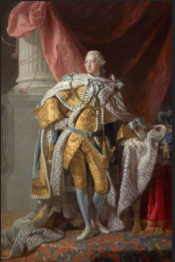King George III: Colonial Relations and Shifting Sentiments
King George III, ascending to the throne in 1760, reigned over Great Britain during a tumultuous period in colonial American history. Initially hailed with praise by the colonists, his relationship with the American colonies deteriorated over time, leading to significant tension and eventually revolution.
Casey Adams
12/23/20233 min read


Early Reign and Popularity
When King George III ascended to the throne in 1760, he was initially welcomed with enthusiasm by his subjects, including those in the American colonies.
Known for his moral character and dedication to his duties, George III represented a shift from the perceived excesses of his predecessors.
His coronation was celebrated across the Atlantic, with colonies erecting statues and organizing festivities in his honor.
This symbolized a shared sense of unity between Britain and its colonial territories.
The Seven Years' War: A Costly Victory
The conclusion of the Seven Years' War (1756–1763) was a significant milestone early in George III’s reign.
Britain emerged victorious, securing vast territorial gains, including Canada and Florida. However, the war left Britain deeply in debt.
The Crown’s efforts to recover financially by taxing its American colonies marked the beginning of growing tensions.
Initially, George III was praised for his leadership during the war, but the economic burdens it imposed led to strained relations with the colonies.
The Taxation Controversy and Colonial Discontent
In 1765, the British Parliament passed the Stamp Act, the first direct tax on the American colonies.
Colonists reacted with outrage, rallying around the slogan "no taxation without representation.
"This principle became a rallying cry against what they perceived as an overreach of royal authority.
Although the Stamp Act was repealed in 1766, it was soon followed by the Townshend Acts, which imposed taxes on essential goods like paper, glass, and tea. Each new measure deepened colonial resentment.
The Boston Tea Party and Escalating Resistance
The Boston Tea Party in 1773 epitomized colonial defiance.
Colonists, disguised as Mohawk warriors, boarded British ships and dumped an entire shipment of tea into Boston Harbor as a protest against the Tea Act.
King George III viewed this act as a direct challenge to British authority, leading to the passage of the Coercive Acts, or "Intolerable Acts," in 1774.
These measures included the closure of Boston Harbor and the dissolution of Massachusetts’ self-governance, further escalating tensions.
The Road to Revolution
By 1775, open conflict erupted between British forces and colonial militias at Lexington and Concord.
George III’s attempts to quell the rebellion were met with increasing resistance.
In 1776, the colonies formally declared their independence with the adoption of the Declaration of Independence, listing grievances against the King, whom they accused of tyranny.
The once-revered monarch became a symbol of oppression in the colonies.
Statues and Symbolic Rejection
Statues of King George III, once erected as symbols of allegiance, became targets of revolutionary fervor.
In 1776, New Yorkers pulled down a prominent statue of the King in Manhattan, melting it down to make musket balls for the Continental Army.
Such acts underscored the colonies’ transformation from loyal subjects to determined revolutionaries.
Legacy of George III
King George III’s reign was marked by a dramatic shift from admiration to animosity among the American colonists.
While his policies were driven by a belief in maintaining the integrity of the British Empire, they inadvertently spurred the colonies toward independence.
In Britain, George III’s later years were overshadowed by personal struggles, including periods of mental illness.
Nevertheless, his reign—spanning over 59 years—remains one of the most consequential in British and American history.
Conclusion
George III’s legacy is a complex one. For the American colonists, he became a symbol of the tyranny they sought to overthrow.
Yet, in Britain, he is remembered as a monarch who strove to uphold the empire during a time of great change.
His role in the American Revolution highlights the intricate dynamics of power, resistance, and the eventual birth of a new nation.
References:
"George III: America's Last King" by Jeremy Black
"George III: A Personal History" by Christopher Hibbert
"The King Who Lost America: George III and Independence" by Alan Palmer
"George III and the American Revolution: A Study in Personality and Politics" by Frank W. Brecher
"The American Revolution: A History" by Gordon S. Wood
"A Great and Glorious Adventure: A History of the Hundred Years War between Britain and the United States" by Gordon S. Wood
"The Stamp Act Crisis: Prologue to Revolution" by Edmund S. Morgan
Journals, letters, and official documents from the British Library and National Archives related to King George III's reign and his policies toward the American colonies.
These references offer a comprehensive insight into King George III's reign, his policies, and the dynamics between Britain and the American colonies during that era.



King George III

